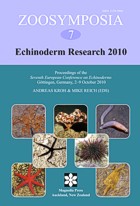Abstract
New data, principally from ‘local’ encrinites in the Yezo Supergroup of Hokkaido, northern Japan, suggest that many relict ‘Jurassic-type faunas’ identified in Europe and central Japan might have persisted in the Late Cretaceous deep-water (> 100 m) muddy sandstone facies found throughout the island of Hokkaido. For example, Isocrinus and Balanocrinus occur in the outer shelf sandy mudstone facies of the Turonian-Coniacian Saku Formation and the Coniacian- Campanian Haborogawa Formation, of the Mikasa area (central Hokkaido), respectively. Isocrinus is also found in the Turonian-Coniacian deep-water siltstones and sandy siltstones of the Nishi-chirashinai Formation of the Nakagawa area (northern Hokkaido). In contrast, Isselicrinus, which belongs to ‘Late Cretaceous type-faunas’, occurs in the uppermost Cretaceous (Campanian) outer shelf mudstone facies of the Upper Yezo Supergroup around Hobetsu (south-central Hokkaido). Although collections of crinoids from the chalks of northern Europe are themselves largely free from sampling biases, Cretaceous crinoid diversity data have been markedly influenced by fossils preserved in the relatively homogeneous chalk facies where the faunal differences between the deep-water Danish, English and north German chalks (> 250 m) and the shallow-water facies found around Maastricht, the Netherlands (< 50 m) are slight. The results of this preliminary report on the crinoid faunas of Hokkaido suggest that global crinoid diversity reported from the Upper Cretaceous might be influenced by sampling and facies biases.

